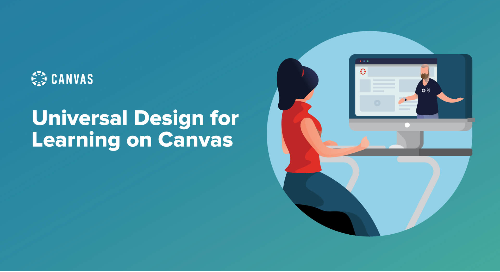
To learn how to implement universal design for learning in Canvas, enroll in this free Canvas Network course.
The other day, a student learning to be an instructional designer asked me, as part of an interview for her class, “do you think teaching is more effective when delivered in person or online?” Oof. I committed a cardinal sin of annoying interviewees by answering with… don’t hate me…
“It depends.”
But it does! I’ve seen a lot of courses that were very successful in-person classes “moved online” and roundly fail to deliver the same kind of outcomes as they did in their brick-and-mortar origins.
I’ve also seen courses delivered online that enabled learners in different contexts, with different needs to express themselves, engage, and succeed in ways that I don’t believe they could have or would have if they attended class on Monday, Wednesday and Fridays from a desk.
A Different Kind of Space
I went on to talk with my interviewee about how the success or failure of any educational experience depends on whether we design for the strengths of the setting, the purpose, and the learners involved. For generations, we have explicitly considered and addressed the value of good learning objectives and methods and materials. For generations, we have explicitly considered and addressed the role of the learner in the educational experience.
But only in recent years have we really been called to confront how this new digital setting of online learning changes the rules that govern our learner’s behavior, our materials, our methods, and even our learning objectives.
As I think about what makes an effective online learning experience effective, I believe it starts with someone creating the experience in a way that utilizes the strengths of the online environment and mitigates its limitations. When done well, online course design can equip variable learners to be as - or more - successful than they could in the face-to-face classroom.
When we come to terms with the fact that a discussion board is not the online equivalent of a face-to-face discussion, we’ve taken a step in the right direction. When we begin thinking about what we can do with digital media or self-pacing or asynchronous collaboration in online learning, which would be awkward in face-to-face settings, we take a big leap toward actualizing the potential of online learning.
It’s by Design
The Universal Design for Learning (UDL) guidelines and framework offer a powerful way to begin rethinking how we create learning experiences (including online). The principles of UDL enable course designers to proactively and intentionally create spaces that meet learner’s variable needs while helping support engagement, supporting the development of executive functions, enabling a wider range of expression, and ultimately leading to more robust outcomes for more people.
I find that talking about designing courses online is a wonderful place to be introduced to UDL or to take what you know about UDL and put it into practice in a new way. “Implementing UDL on Canvas” is not just a PD course that explores the intersection of UDL with Canvas course design, it also models it. I invite you to explore the ideas presented in the course through both form and content. I hope you find it to be a rich collection of practical strategies that you can carry immediately into your own course design.
Whether in person or online, good courses don’t just happen. They are the product of intentional, quality design that unites and coordinates learners, curriculum, and setting to maximize outcomes. UDL is a great way to frame quality course design through the intentional choices on which … well… it depends.
Keep learning,
Dr. Eric J. Moore
UDL and Accessibility Consultant & Speaker, Innospire.org
UDL and Accessibility Specialist, University of Tennessee Knoxville
Related Content
![teaching with tech thumbnail]() Teaching-With-Tech-10-Benefits.jpg
Teaching-With-Tech-10-Benefits.jpgBlogs
 breakingdownsilos.png
breakingdownsilos.pngBlogs
 canvas-biz-investment.jpg
canvas-biz-investment.jpgBlogs
